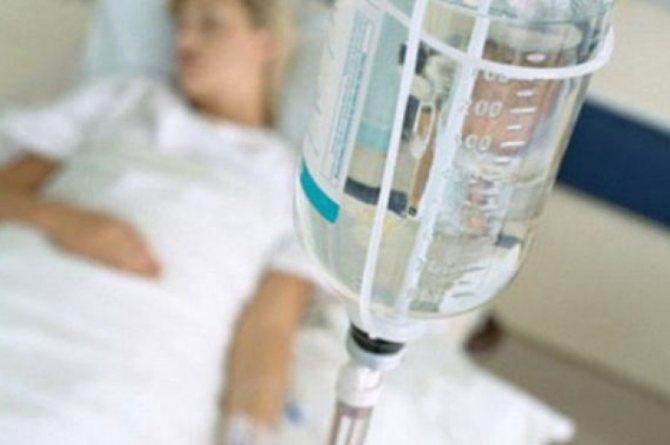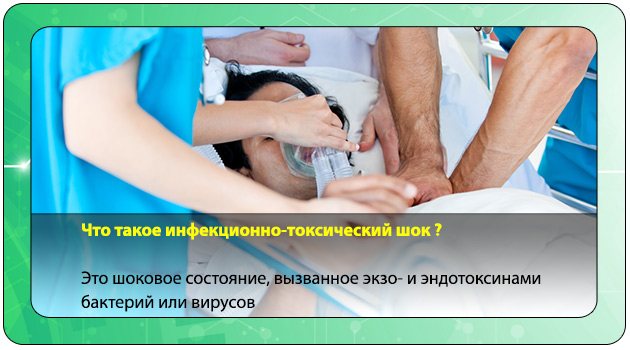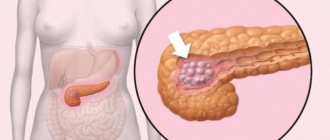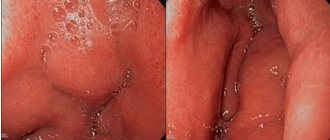Typhoid fever is a disease from the group of so-called intestinal infections (they also have a fecal-oral transmission mechanism). The disease is characterized by penetration of the pathogen into the blood (bacteremia), prolonged temperature reaction, general intoxication syndrome, specific ulcerative lesions of the small intestine, and disruption of the central and peripheral nervous system.
In practical healthcare, at the stage of preliminary diagnosis, that is, before receiving the results of a specific examination, the diagnosis of “typhoid fever” is usually replaced by the complex concept of “typhoid-paratyphoid disease”. Based on clinical symptoms and epidemiological features, it is almost impossible to distinguish between typhus itself and paratyphoid A, B, C. From the point of view of laboratory and instrumental examination, as well as treatment tactics of a particular patient, there are no special differences, therefore it is quite possible to make a specific diagnosis after a long time from the onset of the disease.
Typhoid fever was described as an independent disease only at the end of the 19th century by the Russian doctor S.P. Botkin, almost at the same time, isolated a pure culture and the causative agent of typhoid fever, which was named after the name of its discoverer - Ebert's bacillus.
Relevance and geographical distribution
The highest level of annual incidence of typhoid fever is observed in regions with tropical and subtropical climates, as well as in countries with a low level of sanitary culture.
A significant reduction in the incidence of this infection on the territory of the USSR was achieved thanks to the strict implementation of all sanitary, hygienic and anti-epidemic measures. Currently, the incidence remains at a sporadic level (isolated cases of the disease among unrelated individuals); local outbreaks are extremely rarely recorded.
It should not be assumed that the world community is any closer to eliminating this infectious disease - in modern conditions this is impossible.
The following points contribute to the persistence of foci of typhoid infection and their periodic activation:
- lack of medical alertness - the diagnosis of typhoid infection is established at 3-4 weeks of illness;
- late request of the patient for qualified medical care;
- formation of resistance to traditional antibacterial agents (chloramphenicol and chloramphenicol succinate);
- untimely identification and not always adequate treatment of carriers (an active source of infection in typhoid fever);
- intensive migration of the population and high speed of movement from different parts of the planet (for example, a carrier of typhoid infection from India can end up in a European country within a few hours);
- the occurrence of natural and man-made disasters that lead to violation of sanitary and hygienic standards and activation of infectious agents.
Specific prevention of typhoid fever has been developed and applied, however, it is not a 100% effective means of protection against this infectious disease.
Ways of transmission of the disease

There are three main ways of contracting typhoid fever and they look like this:
- Through water that contains the pathogen.
- Through contaminated food products.
- From a sick person to a healthy one.
Children most often become infected with the disease through direct contact with a sick child, as well as through household items and toys . So an infected child plays with toys, which are then taken by healthy children, and a massive infection occurs.
Infection can occur when using the same dishes, towels, combs and bedding.
People who like to swim in natural bodies of water and swimming pools are most often infected through water. Not all people know that waste water from enterprises and sewage can often flow into the buildings. However, the most interesting thing is that an infection that was picked up through contaminated water can be treated much easier and faster than one that entered the body through food and household contact.
Another source of infection for typhoid fever is raw milk . Lovers of dairy products made from cows should remember that milk and cottage cheese can only be consumed after heat treatment. It is strictly forbidden to drink raw milk or make curdled milk from it. In addition, you can become infected with typhoid by eating salads with mayonnaise, jellied meat, pate, vinaigrette and other dishes. This occurs when the preparation technology and storage conditions are violated.
There are often reports in the news that after celebrating an anniversary or a wedding in an inexpensive restaurant, those invited as an unpleasant surprise receive typhoid fever and long-term hospitalization within the walls of a medical institution.
Any transmission of typhoid fever is not dangerous for children under one year of age who are breastfed. With mother's milk they receive good immunity to this disease.
Brief characteristics of the pathogen
The microbiology of the causative agent of typhoid fever (Salmonella typhi) is in some respects similar to other representatives of Salmonella. This microbial agent is pathogenic (causes the development of disease) only in humans.
Salmonella typhi is a gram-negative microorganism and a facultative aerobe. The causative agent of typhoid infection does not have any significant morphological features or differences from other Salmonella. This microbe does not form spores or capsules and has 10-12 flagella.
Salmonella typhi is characterized by a stable antigenic structure: the presence of O and H antigen. Only the causative agent of typhoid fever has a so-called virulence antigen (Vi antigen). In difficult diagnostic cases, performing serological reactions with this particular antigen makes it possible to distinguish typhoid fever itself from paratyphoid fever.

Salmonella typhi can be distinguished from other types of salmonella by certain biochemical properties. The microbiology, or more precisely the biochemistry, of the pathogen is reflected in the international Kaufman classification of Salmonella.
The causative agent of typhoid infection grows well on the most common (traditional) nutrient media, but best of all on those that contain bile. The characteristic external features of Salmonella typhi colonies have not been described.
This microbial agent is quite resistant to environmental factors. For several months it remains active in water (including well and tap water), on the surface of unwashed fruits, berries and vegetables. It dies quite quickly when treated with high temperature, various disinfectants and ultraviolet radiation.
Clinical picture
At the incubation stage (1-3.5 weeks) no symptoms are provoked. The virus is localized in the blood and infects the lymphatic system. The pathogenesis of typhoid fever is similar to that observed with paratyphoid fever. Bacteria are transmitted through the mouth; salmonellosis begins in the small intestine. The pathogen moves exclusively through the lymphatic tract. This is where inflammation develops. The patient does not feel anything.

The causative agent of typhoid fever
Blood cultures are then formed and released into the bloodstream. Serological picture: it is possible to isolate the bacterium in the form of a strain and make a diagnosis. Sometimes the pathogen is found in the blood before the end of the disease. The immune system, killing foreign bodies, releases endotoxin. The first clinical signs appear:
- Intoxication.
- Dyspepsia.
- Temperature.
A characteristic symptom is a rash that disappears with pressure. The bacteria now infect the hematopoietic system. Negative processes develop in the intestinal epithelium. Symptoms begin to subside in the fourth week. Then recovery comes. The temperature curves take the form of a gentle hill. In case of relapse, a second hump (apex) appears.
The complications encountered mainly concern the intestines. Treatment methods solve the problems of bleeding and perforation of the epithelial wall. Some patients require emergency surgery. Extraintestinal complications are the prerogative of the surgeon.
How is typhoid fever transmitted?
The routes of infection and other features of the epidemiology of typhoid fever are the same as those of other intestinal infectious diseases. That is, typhoid fever is a classic anthroponotic infectious disease. The source of the pathogen in this case is only a person with clinical manifestations of the disease of any severity, as well as a healthy carrier. According to anti-epidemic rules, a patient, even with a preliminary diagnosis of “typhoid-paratyphoid disease,” must be hospitalized in the infectious diseases department. Therefore, the sick person himself, who is in isolation, does not pose a danger to others.
The most relevant source of infection is the so-called healthy carrier, that is, a person without clinical signs of this infectious disease. The fact of carriage is detected by chance, only during a comprehensive specific examination. All biological fluids of such a person contain a huge amount of the pathogen, which explains the simplicity and ease of infection.

Transmission of infection from the carrier to other people can be observed over many months, in rare cases – several years.
Typhoid infection can be transmitted in the following ways:
- water - when using unboiled water (well, artesian and even tap water) for drinking or hygienic purposes;
- food - when using fruits and vegetables, as well as any culinary dishes that do not undergo culinary processing, contaminated with a pathogen;
- contact-household - in direct contact with a person - the source of infection or the use of common household items (dishes, towels, hygiene items, children's toys, etc.).
Susceptibility to typhoid fever is high in all age groups, especially often the disease develops in people with immunodeficiency, malnutrition and weakened by chronic diseases.
Pathogen carrier
The predominant route of transmission of infection is the human carrier. A carrier is considered to be a person in whom the disease does not manifest itself in any way, but releases the pathogen into the environment . This release can last from a couple of weeks to 2-3 decades. This is explained by certain objective reasons.

This is primarily observed in people who have recently had an infectious disease. During the rehabilitation period, bacilli carriage can be either short-term or quite long. But the short-term form is most often observed after dysentery and salmonellosis; with typhoid fever, a person releases the pathogen into the natural environment for a long time.
Doctors identify immune carriers of this microorganism. These include those people who have been vaccinated against a dangerous disease.
Sometimes typhoid fever occurs atypically, that is, there are no pronounced symptoms that indicate this disease . Patients with this form are treated at home for a long time without seeking medical help. As a result, family members and people from the immediate environment become infected. Most often, infection occurs through food, especially dairy products. The typhoid bacillus not only lives in such products for a long time, but also actively reproduces.
People are quite susceptible to typhoid fever. In those areas where an outbreak of the disease is registered, up to half of the entire population may become ill.
Typhoid fever is still considered a life-threatening disease that affects not only the digestive organs, but also the nervous system. That is why it is so important to diagnose and treat this pathology in a timely manner.
Pathogenesis of typhoid fever
The development of clinical symptoms of typhoid fever in the human body occurs in accordance with certain stages.
These include:
- Penetration of Salmonella typhi through the oral cavity into the body.
- Development of an inflammatory reaction in the lymph nodes and lymphatic vessels.
- Systemic bacteremia (entry of the organism into the blood and its spread throughout the body).
- General intoxication syndrome as a natural reaction to waste products of a microbial organism.
- Parenchymal (intraorgan) diffusion.
- Gradual elimination of the pathogen from the human body.
- Possible allergic reactions.
- Formation of immune reactions.
With the development of a relapse or complication, some links in the pathogenesis may be repeated in their development.
Pathogens and routes of infection of typhoid fever
Typhoid fever is a terrible disease that claimed many lives in the 19th and early 20th centuries and returned to us again at the beginning of the 21st.
The causative agent is Salmonella, its special serotype. It contains a toxin that affects the nervous system, which enters the bloodstream when bacteria are destroyed. Typhoid Salmonella, like all Salmonella, is stable in the external environment and can survive in water and soil for several months. They breed on dairy products, minced meat and jelly. They die when boiled and treated with disinfectant solutions.
The transmission mechanism is fecal-oral. Animals do not suffer from typhoid fever. Typhoid fever is transmitted from person to person. You can become infected from the bacteria carrier through water, food and dirty hands.
Contamination of water in a well or other water source, or contamination of food in a communal kitchen or food establishment can cause a localized epidemic.
Having entered the intestines through the mouth and stomach, typhoid Salmonella invades the local lymphatic system, where it multiplies in peripheral lymph nodes and enters the bloodstream. Here the immune system begins to fight them. Some of the bacteria die, and the toxin enters the blood, which causes symptoms of intoxication and impaired consciousness.
Surviving salmonella infect internal organs (forming so-called typhoid granulomas) and skin, causing a rash. Then they begin to be excreted along with bile, urine, sweat, and saliva. Some of them, once again in the intestines, are introduced into the lymphatic system, finally destroying lymphatic plaques, which leads to the formation of ulcers in the intestines.
Typhoid Clinic
The incubation (latent) period for typhoid infection ranges from 1 to 2 weeks, in rare cases it extends to 1.5 months.
At the initial (prodromal) stage, a person feels only nonspecific signs of malaise, namely:
- gradual increase in clinical symptoms (over several days or even weeks);
- constantly elevated temperature (sometimes to very high numbers), normalization of temperature occurs only in the 3rd-4th week of illness;
- constant fever is combined with insomnia and persistent headache;
- a little later, signs of dyspeptic syndrome appear: loss of appetite;
- moderate intensity diffuse abdominal pain;
- nausea in combination with vomiting;
- loose stool without pathological impurities, which is replaced by constipation.
When conducting an objective and subjective examination of a patient with a preliminary diagnosis of “typhoid-paratyphoid disease,” the doctor can identify:
- adynamia and lethargy of the patient, indifferent attitude towards others and his own condition;
- pronounced pallor with a characteristic “waxy” tint of the skin;
- on the 8-10th day of the disease, an exanthema occurs - a pinpoint rash on the anterior wall of the abdomen;
- the elements of the rash are often single, it can appear for 2-3 days, after which all the elements disappear without a trace;
- dyspeptic symptoms of typhoid fever persisting throughout the height of the period;
- a tongue heavily coated with a brownish-yellow coating with visible teeth marks;
- enlarged liver and (to a lesser extent) spleen;
- fluctuations in blood pressure, pulse rate that does not correspond to the temperature (this is called relative bradycardia).

As appropriate therapy is carried out, the symptoms of typhoid fever gradually decrease and disappear without a trace. As a rule, the rash of typhoid fever is not detected first, the signs of general intoxication are reduced, and the size of the internal organs is normalized.
In some cases, typhoid infection can occur with complications and relapses. Relapse is understood as the return of the original clinical symptoms after a decrease in their severity. The occurrence of a relapse of the disease may be associated with individual characteristics, irrational antibiotic therapy, or violation of the treatment regimen.
Symptoms and causes of typhoid fever
The occurrence of the clinical picture is associated with two main pathogenetic factors:
- Contamination of organs by microorganisms, causing the formation of specific inflammatory foci, which are called granulomas.
- The release of the most powerful typhoid endoxin by the bacterium, which occurs due to the destruction of Salmonella under the influence of the human immune system. Such an immune response can cause irreparable harm to health, as it threatens the development of septic shock due to the massive intake of toxic substances.
Complications of typhoid fever
In fact, these are the consequences of typhoid fever that can lead to serious health problems or even death of the patient. Among the most dangerous are intestinal bleeding and (or) perforation of the intestinal wall.
The most serious specific complication of typhoid fever is bleeding. It may be minor when only a small vessel is damaged and the bleeding may well stop on its own. In other cases, the integrity of a large main vessel is compromised - a rapid loss of a large amount of blood occurs, which poses a serious threat to the patient’s life.
The following signs indicate the presence of bleeding:
- increasing pallor of the skin;
- rapidly decreasing temperature;
- increased heart rate;
- increasing, but not unbearable, diffuse pain in the abdominal area.
Perforation is the formation of an unnatural hole in the intestinal wall. The contents of the intestine spill into the abdominal cavity - inflammation develops (peritonitis). Only early surgical intervention (no later than 4-6 hours from the moment the complication develops) can save the patient’s life.
Classification
All negative consequences of the disease are divided into two large groups: specific and nonspecific. The first include:
- intestinal bleeding;
- wall perforation;
- infectious-toxic shock.

Another type includes secondary foci of inflammation, localized in all organs and tissues: meningitis, cholecystitis, pancreatitis and others.
General principles for diagnosing typhoid fever
In practical healthcare, a distinction is made between nonspecific (general clinical and instrumental) and specific (aimed at isolating the pathogen) diagnostics.
To obtain definitive information about the presence (absence) of the causative agent of typhoid infection, the following studies are carried out:
- sowing stool, urine and blood (less often duodenal contents, vomit and roseola imprint) on media that contain bile;
- Widal reaction or RNGA (RPGA) with typhoid antigen;
- reaction with a virulence antigen to distinguish typhoid fever proper from paratyphoid fever.
It is important to distinguish the so-called healthy carrier state from the manifest clinical form of the disease. 100% confirmation of typhoid infection itself is the release of a microbial agent from the blood. In carriers, this situation is impossible (the situation is normal in human blood), but the pathogen can be isolated from feces and (or) urine.

A diagnostically significant criterion for the diagnosis of typhoid fever is positive serological reactions. Repeated serological tests and detection of an increase in the titer of protective antibodies is an indisputable confirmation of the diagnosis.
Diagnosis of the disease and complications
To select the most appropriate treatment, a thorough diagnosis is carried out. The medical worker talks with the patient and identifies complaints. In the future, specific examinations are prescribed.
Research:
- General blood and urine tests.
- Bacteriological blood culture for sterility.
- Determination of the presence of antibodies to salmonella.
The abdomen is palpated to determine the condition of the liver and other organs. If necessary, the doctor will prescribe additional tests. It is necessary to differentiate typhoid fever from similar diseases (dysentery, salmonellosis). After all examinations, treatment is prescribed.
Irritation, a feeling of sand in the eyes, redness are only minor inconveniences with impaired vision. Scientists have proven that vision loss in 92% of cases ends in blindness. Crystal Eyes is the best way to restore vision at any age.
Typhoid fever is a dangerous disease that can lead to serious complications. In the absence of proper treatment, the functioning of internal organs is gradually disrupted. There are several of the most dangerous complications.
Consequences:
- toxic shock;
- perforation of the small intestine;
- bleeding in the intestines.
The latter complication is often asymptomatic and is detected only after specific examinations in a medical institution. Typhoid fever can cause death. Therefore, treatment must be started on time.
General principles of therapy
Treatment of typhoid fever (and paratyphoid fever) involves the following components:
- therapeutic dietary nutrition;
- strict bed rest (during the entire period of peak);
- antibiotic therapy;
- pathogenetic and symptomatic agents.
Dietary nutrition and strict bed rest are necessary to ensure functional and mechanical rest of the digestive canal. Any, even the most minor provocation can lead to the development of complications or relapse of the disease.
Among the first-line antibiotics, chloramphenicol succinate is most often used. If there is no positive dynamics in the clinical picture, it is possible to replace it with ampicillin or fluoroquinolones. It is necessary to continue antibiotic therapy until the 10th (12th) day when the patient’s body temperature is absolutely normal.
Among the most frequently prescribed pathogenetic and symptomatic drugs are:
- polyionic and colloidal solutions to reduce intoxication;
- enzymes to improve digestion processes;
- vitamins B, C and E;
- antipyretics (ibuprofen) or physical methods of lowering temperature;
- hemostatic agents for signs of intestinal bleeding.
General principles of prevention
In terms of prevention, the most effective and expedient is not the typhoid vaccine, but sanitary and hygienic measures. Anti-epidemic measures for typhoid fever, that is, isolation of the patient (in a hospital) and the implementation of final and ongoing disinfection, play a huge role in preventing infection of still healthy people.
Vaccination is indicated only if a person travels for a long time from a relatively safe zone to a high-risk region. However, it should be remembered that none of the currently used vaccine options protects against the possibility of infection 100%.
Diagnostics
Usually, when complications develop, the disease has already been detected in the patient and all necessary tests have been carried out, namely:

- general and biochemical blood test;
- Widal reaction (detection of antibodies to the causative agent of typhoid fever);
- serological examination (RNGA, ELISA);
- bacterial seeding of biological material.
When bleeding occurs from “dirty” or “clean” ulcers of the intestinal mucosa, the doctor prescribes an additional stool test for occult blood, colonoscopy, and monitors hemodynamic parameters.
In case of organ perforation, a special role is played by the symptomatic complex, palpation and auscultation of the intestine. Against the background of perforation, you can feel the tension of the anterior abdominal wall with your fingers, and peristalsis is inaudible in the stethoscope. To confirm the diagnosis, computed tomography and diagnostic laparoscopy can be performed.
Infectious-toxic shock is characterized by changes in the cardiovascular and urinary systems, a sharp increase in the number of leukocytes in the blood; specific tests are usually not performed.

The presence of secondary inflammatory foci can be indicated by radiography of the organ, ultrasound, and magnetic resonance imaging.









